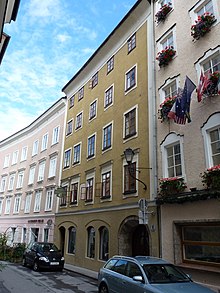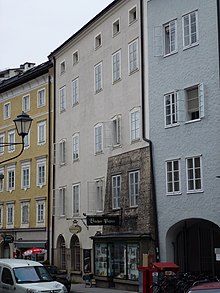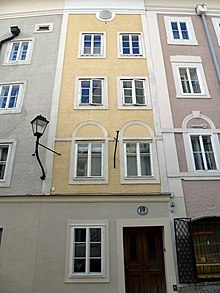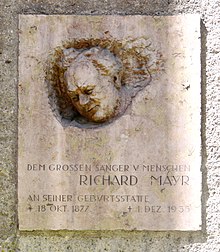Bergstrasse (Salzburg)
The mountain road is nearly 200 m long, existing since the Middle Ages street in the right historical center of Salzburg and is within the UNESCO World Heritage Site declared Salzburg center . The street borders on Dreifaltigkeitsgasse to the west and Linzer Gasse to the east .
history
In the time of the prince-archbishop, the Bergstrasse was the important right-bank arterial road towards Bergheim , which was first mentioned in a document in 1365. The street was largely given its present appearance under the Count Paris von Lodron . At the northern end of today's Dreifaltigkeitsgasse (formerly the outer part of Bergstrasse) there was once the Bergstrasse Gate, which was part of the 2nd city fortifications and was built between 1464 and 1480. After the construction of the Lodron defense system in the Thirty Years' War , the gate lost its defensive character, but was partially preserved as the "Mitterbachbogen" (at the end of the old Bergstrasse towards Mirabellplatz) until 1894. In the time of the prince- archbishop, Bergstrasse was also repeatedly called the wood market and for a time was called the “old wood market” in the section on the Linzergasse side.
The closest Priesterhausgasse is named after the local priest house. The southern part of the street was formerly called Schmiedgasse, the northern part was called Pfaffengasse.
The Cornelius-Reitsamer-Platz is named after Cornelius Reitsamer (1857–1930), who made lasting merits as commander of the fire brigade in the nearby Bruderhof in Linzer Gasse. This square used to be part of Priesterhausgasse or Schmiedgasse.
The Bergstrasse and its craftsmen
In its long history, Bergstrasse was primarily the home and work of craftsmen. Among other things, the court organ maker Johann Christoph Egedacher moved his workshop from Mülln to Bergstrasse 12 around 1706 , which his son Johann Rochus Egedacher took over in 1747 until he moved his workshop to Linzer Gasse 66.
Brush house
The house at Bergstrasse 8 was first mentioned in a document in 1429. The building, which is essentially late Gothic, received its current facade and gable roof after 1850. A large late Gothic arched portal stands out on the ground floor. In 1882, Hugo Wolf, then assistant conductor of the Salzburg City Theater, lived in a small chamber in the house of the . A memorial plaque reminds us: “Hugo Wolf (Windischgrätz / Slovenji Gradec, Lower Styria, 1860–1903, Vienna), the great master of German song, lived in this house. The Salzburger Liedertafel 1936 "
House Bergstrasse 10
The early modern house is first mentioned in 1650. At that time it was referred to as "a stöckhl outside the garden belonging to the Closter Loreta except for the clausur sambt the brick barn stuck in it". The current facade design dates back to 1884. The house has a memorial plaque for the founder of the Austrian Nature Conservation Union and the House of Nature, Prof. Paul Eduard Tratz , who was born in this house on September 25, 1888.
Former Collegium Marianum
(Bergstrasse 16) In 1564 this house is owned by Wilhelm Alt from the well-known Salzburg family. Paris Lodron built the Collegium Lodronio-Marianum in 1645 to secure a future capable civil service and bought the Doktor Knollische Haus in Bergstrasse. 8 to 14 youngsters were to be trained there, 3 of them from the area of the Lodron headquarters in the Trient area , from the Villa Lagarina (in Welschtirol, today province of Trentino ). 1649-1665 also included the Ansitz Penninghof including basic rule for Paris Lodronschen Collegium Marianum .
The college was under the direct supervision of a spiritual educator. The pupils received food, accommodation, clothing and linen as well as training. After completing their training, the pupils had to work for a small fee in the Lodron Primogeniture for two years (→ Paris Lodronscher Primogeniturpalast ).
The home was directly subordinate to the respective rector of the Salzburg University . The houses Bergstrasse 14, 16, 18, 20 and 22 were all once owned by the Counts of Lodron and belonged to Lodron's primogeniture.
The novel Silentium! von Wolf Haas is set at a Marianum in Salzburg, a fictional setting that refers to this historical institution.
House Bergstrasse 19
The house first mentioned in 1507, at that time owned by Örtl the dyer, was owned by the playgrave Hanns Wilhelm in 1650. The "Spielgraf" issued, among other things, the permits to the country music to participate in festivals and celebrations. The name of the building "Wasenbrennerhaus" ("Waßerbrennerhaus") is remarkable. It reminds of the time of the wasenstecher work in the nearby Schallmoos, which was still common in the 19th century. The dried moor was used as fuel in many ways.
Gablerbräu
(Stefan-Zweig-Platz, formerly Cornelius-Reitsamer-Platz) This inn was called “Stainhaus peym Ostertor” around 1400, after the fortified city with the Ostertor in Linzer Gasse ended in 1408, it is also known as “prewhaus” , so as a brewery and tavern. The name Gablerbräuhaus is known for the first time around 1685. The name of the house is probably older. A “Gabler” once meant a (staircase) brewer. Today the address of the house is Linzer Gasse .
In the 19th century, the inn came into the possession of the Mayr family, who lived in the Rauchbichlerhof after 1881 . The best-known family member is the opera singer Richard Mayr , who was a soloist at the Vienna Court Opera and at the Salzburg Festival . He became world famous in the role of Ochs von Lerchenau in Rosenkavalier by Richard Strauss . A plaque with a relief portrait on the house where he was born commemorates the singer: “The great singer and man Richard Mayr. At his birthplace. - * Oct. 18, 1877; † Dec. 1, 1935 (Vienna). ” The nearest short“ Richard Mayr-Gasse ”was also named in his honor.
literature
- Friedrich Breitinger / Kurt Weinkamer / Gerda Dohle: craftsmen, brewers, landlords and traders . Salzburg's commercial economy during Mozart's time, ed. by the “Franz Triendl Foundation” of the Salzburg Chamber of Commerce and the Society for Salzburg Regional Studies , at the same time: Communications from the Society for Salzburg Regional Studies, 27th supplementary volume, Salzburg 2009.
- Bernd Euler, Ronald Gobiet, Horst Huber: Dehio Salzburg - City and Country. Verlag Anton Schroll & Co, Vienna 1986, ISBN 3-7031-0599-2
- FW Zillner: History of the City of Salzburg, - special volumes of the Society for Salzburg Regional Studies , Salzburg 1885
Individual evidence
- ↑ Measurement on the official Geographical Information System of the State of Salzburg (SAGIS) ( Memento of the original from September 6, 2012 in the Internet Archive ) Info: The archive link was inserted automatically and has not yet been checked. Please check the original and archive link according to the instructions and then remove this notice.
Web links
Coordinates: 47 ° 48 '12.9 " N , 13 ° 2' 44.1" E



